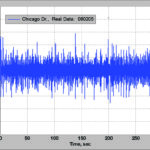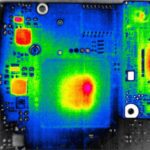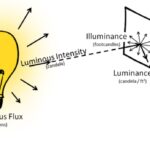Humidity is the concentration of water vapor in the air. Too much or too little humidity can be detrimental to the functioning of electronic devices. This FAQ begins by looking at some basic concepts related to humidity and the impact that humidity can have on electronics. It then looks at the importance of using humidity in accelerated life testing of electronics and various ways of measuring humidity and closes by considering the ‘humidity paradox’ and the expectation that rising temperatures from global warming should result in higher levels of humidity, but actual humidity measurements are declining.
The three basic measurements of humidity are; absolute, relative, and specific. Absolute humidity is expressed in terms of grams of water vapor per cubic meter of air or grams of water vapor per kilogram of air. Relative humidity (percent RH) is usually expressed as a percentage and measures the current absolute humidity level compared with the maximum humidity level possible at the same temperature. Specific humidity measures the ratio of water vapor mass to the total mass of the air plus the water vapor.
The ability of air to hold water vapor — humidity — depends on the pressure and temperature of the air. For example, the same grams of water vapor results in higher humidity in cool air than warm air. And the amount of water vapor needed to reach saturation increases as the temperature increases. For example, at 30°C, a cubic meter of air can contain 28 grams of water, while at eight °C, a cubic meter of air may hold only 8 grams of water.
Air pressure and partial pressures are important concepts related to humidity. Atmospheric pressure at sea level generates a force of about 101,000 Newtons per square meter, which is defined as one Pascal (Pa) of pressure. That pressure is the sum of the partial pressures of the constituent gases in the atmosphere, including the water vapor, which is the most variable component. The water vapor saturation pressure corresponds to the maximum water vapor pressure at a given temperature. percent RH defines what percentage of water vapor is present at that temperature relative to the saturation point, and it varies with temperature (Figure 1).

Dew point
Electronic devices and systems are usually rated for operation under limited humidity conditions such as 10 to 90 percent RH. Regardless of the stated operating humidity range, a particular concern with electronic devices is condensation and the dew point. The dew point in the air temperature needs to be cooled to (at constant pressure) to achieve 100 percent RH. At this point, the air cannot hold more water in the gas form. If the air were to be cooled even more, dew could occur, which can cause corrosion and electric shorts, which leads to serious damage to electric equipment (Figure 2). This temperature varies depending on humidity and pressure.
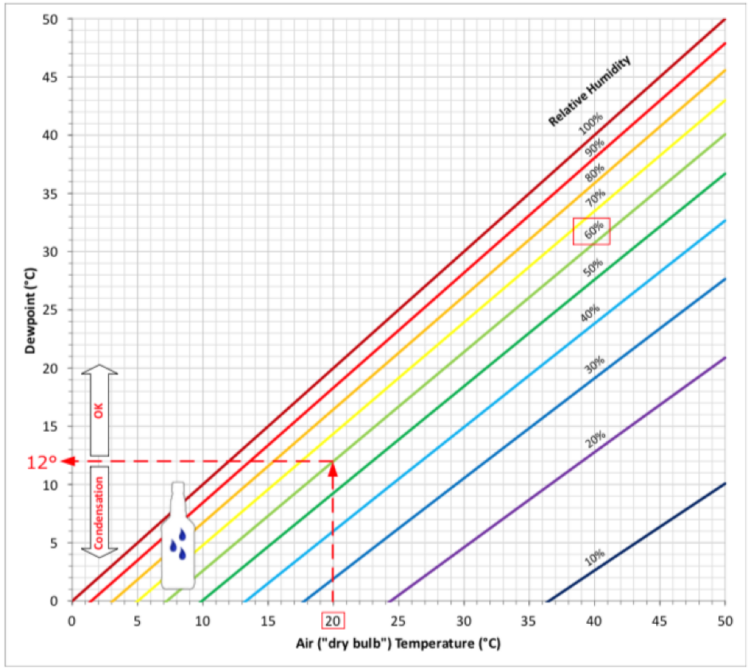
THB and BHAST testing and ESD
Elevated humidity levels are important in accelerated life tests and in tests designed to stress devices to the point of failure. Two common tests are the biased highly accelerated temperature and humidity stress test (BHAST) defined by the Joint Electron Device Engineering Council (JEDEC) JESD22-A110 and the steady-state temperature humidity bias (THB) life test defined by JESD22-A101. These tests are collectively called the 85/85 tests for 85°C and 85 percent RH since these are performed under conditions of at least 85°C simultaneously with 85 percent RH.
A BHAST requires 96 hours of electrical biasing while maintaining 130°C and 85 percent RH, in addition to a water vapor pressure of 33.5 pounds per square inch absolute (PSIA) (note: the vapor pressure of water at room temperature is 0.2 psi absolute pressure) to accelerate the formation of corrosion within the device. BHAST is designed to ensure that semiconductor devices will operate reliably even when exposed to humid environments by accelerating the penetration of humidity into the package and onto the semiconductor die.
A THB test is less stressful and eliminates the pressure component of the BHAST. THB tests for the same failure mechanism but with a much lower acceleration factor. Instead of running for 96 hours, a THB test can run for 1,000 hours. THB and BHAST can also be useful for testing completed printed circuit boards, connections, and other system elements affected by humidity and temperature.
Low humidity can also be harmful to electronic devices. Materials can become brittle if humidity is too low. And low humidity can result in electrostatic discharges (ESD) that can cause dielectric breakdown and irreversible damage to semiconductor devices and other components. As a result, large installations such as electronics manufacturing facilities, hospitals, and data centers often monitor humidity levels.
Humidity in the air acts as a natural conductor, draining off any potential static charge. The lower the humidity, the higher the risk of static electricity buildup and ESD. In general, an RH below 40 percent can result in ESD concerns. At an RH lower than 30 percent ESD charges can exceed 10kV (Figure 3). Static buildup and ESD concerns are eliminated when the RH is above 55 percent, and moist environments with sensitive electronics seek at least 55 percent RH.
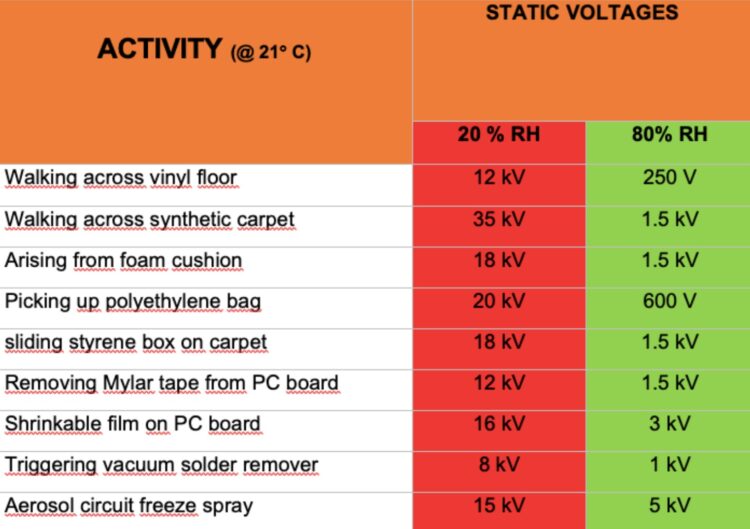
Measuring humidity
Integrated humidity sensors used in electronic systems typically measure percent RH and temperature. By combining those measurements, accurate absolute humidity and dew point estimates can be derived. The most common humidity sensor technologies in electronic systems are resistive and capacitive.
Resistive humidity sensors can be sensitive to chemical vapors and smoke and often cannot be used at 60°C or more temperatures. However, they are low cost and small. They compete with capacitive sensors in industrial, domestic or residential, and commercial applications that do not require a high-temperature operation.
Capacitive humidity sensors are available for operation from -40 to +125 °C. They have a stable operation of long periods and can measure wide ranges of percent RH. Their output voltage is linear. Typical applications for capacitive humidity sensors include HVAC systems, automobiles, aerospace, medical devices, refrigerators, ovens and dryers, printers, and FAX machines.
In a typical application, a humidity sensor is paired with a microcontroller (MCU). The MCU acquires humidity and temperature data from the sensor, which can monitor the operating environment and determine the absolute humidity and dew point (Figure 4). In an HVAC system, that data controls the system and maintains the desired environmental conditions.
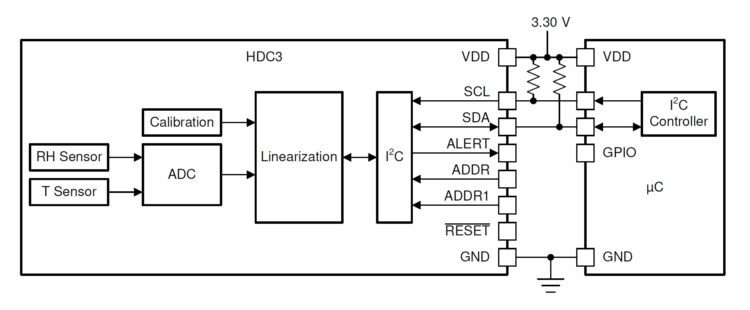
The device must be isolated from all extraneous heat sources to improve the accuracy of humidity sensors. Disruptive heat can be generated by resistive components, batteries, active circuitry, and even some displays. It’s also important to limit the frequency of measurements to avoid self-heating of the sensor. Power consumption is important in battery-powered humidity sensing applications such as HVAC system thermostats. This is another reason to limit the frequency of measurements. Some capacitive humidity and temperature sensors have current consumption below 800 nA when used for measurements made at 1-second intervals.
Global warming and the humidity paradox
Long-term observations of humidity worldwide show that the specific humidity has increased while the percent RH in many regions has declined. This paradox results from the fact that the Earth is getting warmer, and warmer air can hold more water vapor. Without limiting factors, air can hold about 7 percent more water vapor with every 1°C of temperature rise. Put another way, for the percent RH to stay constant under 1°C of warming, the vapor content in the air needs to increase by 7 percent.
In the real world, however, limiting factors are driving down percent RH, even as specific humidity rises. The oceans have been warming slower than the landmasses. The slower warming of the oceans has resulted in less water evaporation than needed to keep up with the rising temperatures of the landmasses. As a result, the atmosphere is not as saturated as it was, and percent of RH has decreased (Figure 6).

Summary
Humidity is an important and complex phenomenon. The use of 85 percent RH levels can be a key aspect of accelerated life testing of electronic components and systems. And once the system is in the field, it’s important that the humidity not get too low to avoid the generation of damaging ESD. In many industrial, aerospace, white goods, and medical applications, humidity sensors are needed to monitor the level of humidity and ensure proper system operation. The complexities of humidity are highlighted in the ‘humidity paradox’ and the expectation that rising temperatures from global warming should result in higher humidity levels, but actual humidity measurements are declining.
References
85°C/85% RH Accelerated Life Test Impact on Humidity Sensors, Texas Instruments
A Guide to the Measurement of Humidity, National Physical Laboratory
Effects of Relative Humidity on Electronics, IQ Home
Humidity, Wikipedia
Investigating climate change’s ‘humidity paradox’, CarbonBrief
Make Your Job Easier with Humidity Conversion Formulas, Vaisala

